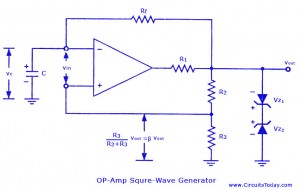hello,
I had few question regarding LM358 square wave oscillator design. The LM358 datasheet contains circuit diagram for square wave generator which is shown below. I have looked at other square wave generator but they normally don't have the resistor R2 which is connected to V+. What is the reason for including this resistor then? Also without this resistor R2 there is no square wave output?

I am using single supply +5V and performed simulation in multisim which are shown below.

And the waveforms on oscilloscope,

which shows voltage peak to peak of about 3.8V or so.
How do I calculate the frequency of the square wave generator and what is the best way I can reduce the amplitude of the output square wave. I require output voltage peak to peak of 500mV.
Thank you
I had few question regarding LM358 square wave oscillator design. The LM358 datasheet contains circuit diagram for square wave generator which is shown below. I have looked at other square wave generator but they normally don't have the resistor R2 which is connected to V+. What is the reason for including this resistor then? Also without this resistor R2 there is no square wave output?
I am using single supply +5V and performed simulation in multisim which are shown below.
And the waveforms on oscilloscope,
which shows voltage peak to peak of about 3.8V or so.
How do I calculate the frequency of the square wave generator and what is the best way I can reduce the amplitude of the output square wave. I require output voltage peak to peak of 500mV.
Thank you




